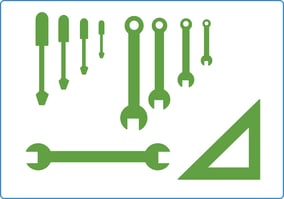ARTICLES & RESOURCES
Explore materials, technologies, design, and manufacturing in the life sciences.
How to Improve Manufacturing Workflow: 5S and Gemba Walks
Every medical production facility strives to provide a safe and efficient work environment for its operators to succeed. When it comes to process improvement, the focus is often put on how workers use materials and equipment; however, these factors do not exist in a vacuum. Enhancing the organization and flow of a work area also leads to process and efficiency improvements. Tools such as 5S and Gemba Walks create an environment where operators maintain and better their own work areas while highlighting what needs more attention. While 5S keeps operators efficient and organized during the daily routine, Gemba Walks spot check the efficiency of the 5S system and help you find other things that might otherwise fly under the radar.
5S is the continuous process of inspecting, evaluating, cleaning, organizing, and focusing a work space. It is used to regularly remove wastes from an area while creating the easiest flow of tools and materials for workers. The five principles (or 5 S’s) are as follows:
- Shine
- Sort
- Set (in Order)
- Standardize
- Sustain
Shine
The Shine principle is focused on cleaning and removing waste from an area. This is also an opportunity to inspect all the equipment and tools at each work station. Any regular preventitive maintenance such as re-greasing a tool can be carried out during the Shine step. Anything in the area that is deemed broken or in need of fixing can be set aside to be serviced. This step should be carried out by the operators who work at the station so they understand the needs of the area and can spot any abnormalities or hazards.
The shine step is also critical in medical and pharmaceutical facilities to maintain cGMP levels. Risk of contamination and system failure decrease when frequent cleaning and inspection take place.
Sort
You might find many unnecessary tools, materials, and waste after the Shine step. This is where Sorting becomes important. The goal of the Sort principle is to remove anything unneeded from a work area. This will free up room for more work, and improve efficiency by removing any obstacles an operator might encounter trying to navigate the station.
Set (In Order)
Once you have cleaned the area and removed all the waste, it’s time to focus on the workflow of the station. In the Set step, organization is key. Everything that the operators use should have a designated storage area. Any tools or materials used together should be stored together and be arranged to follow first-in, first-out flow.

The goal of the Set principle is to create a workflow that ensures quick and easy access to everything needed to run a job. Once all the parts have a place, take pictures of the station or create shadow boards for materials and tools so the operators can easily return items back to their designated place.
Standardize
Shining, Sorting, and Setting lay the framework for how each work station should be, but without Standardization, chaos will take over again. The goal of the Standardize step is to create best practices and good 5S habits around the facility. Writing down cleaning procedures, creating inventory checklists, and training operators on both the steps, and purpose of 5S will cultivate an attitude of continuous improvement in the facility.
Sustain
The final 5S principle is Sustain. It is vital to the 5S system to continuously sustain and repeat the cycle. Occasional implementation of 5S may improve the looks of a work area, but continuous implementation will help operators keep every part in safe, working order and improve production efficiency. Maintaining the cycle will also provide feedback to supervisors on what is and isn’t important.
The key to properly Sustaining the 5S system is in its implementation. Schedule regular trainings and audits, such as Gemba Walks, to reinforce the importance of a safe, clean, and efficient work area. Reward employees for good 5S habits to get them excited about maintaining the system.
Watch our video series about biomedical innovation.
Gemba Walk
A Gemba Walk is one method to audit and evaluate the effectiveness of your facility’s adherence to 5S. These walks are designed to gather a small group of people to asses a specific portion of the manufacturing facility and make observations about workflow efficiency, best practices, safety concerns, waste issues, cleanliness and anything else deemed important by the group. Typically, a Gemba walk includes one of the company executives or Lean leaders, but involving people from all areas of the business can help workers feel united in their involvement in the 5S system. Bringing some people with an understanding of how each manufacturing space functions will also help your team to observe and improve the work area. Ultimately, the who, what, where and how often of your Gemba Walk is up to you.
Conclusion
Continuous improvement is not limited to processes, but must include the manufacturing facility as well. Creating a culture of 5S in the workplace arms operators with the tools to handle the betterment of their areas, and facilitates good habits to maintain a safe and efficient production floor. Using the principles of Shine, Sort, Set (in Order), Standardize and Sustain, through Gemba Walks or other methods, will help you identify and eliminate obstacles to growth in your organization.
ARTICLES & RESOURCES
%20-%20Tint%20100.png?width=106&name=Logo%20-%20Standard%20-%20Blue%20(270%20x%20149)%20-%20Tint%20100.png)
.png)
.png)
.png)